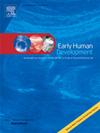The U.S.A. eligible retinopathy of prematurity screening population 2003-2022: WONDER-ROP Study
IF 2.2
3区 医学
Q2 OBSTETRICS & GYNECOLOGY
引用次数: 0
Abstract
Purpose
To delineate the trends of the United States population eligible for retinopathy of prematurity (ROP) screening as defined by the Joint Statement Screening Guidelines of the American Academies of Pediatrics and Ophthalmology from the Centers for Disease Control using the Wide-ranging Online Data for Epidemiologic Research (WONDER) Database.
Design
National, retrospective study.
Subjects
Infants with ROP in the United States between 2003 and 2022.
Methods
Data collected from WONDER database over the 20-year period 2003–2022.
Main outcome measured
The parameters of state, infant birth weight (BW), and last menstrual period estimated gestational age (EGA). Four categories of qualification for ROP Screening eligibility were created: BW, EGA, combined BW and EGA (double eligible infants), and Unique Eligible Infants (UEI).
Results
The number of eligible for ROP screening in the U.S peaked at 56,106 in 2007 and has steadily declined to 41,083 in 2022, averaging 47,088 per year throughout the study period. During the first ten-year period, there was an average of 50,895 eligible infants per year vs 43,281 infants per year during the second ten-year period. This was a statistically significant trend. BW slightly surpassed EGA as a driver for screening eligibility every year. Both the numbers of eligible micropremature (24–26 weeks GA and/or BW 600–800 g) infants and numbers of eligible nanopremature (<24 weeks GA and/or BW <600 g) infants mirrored the trendline overall eligibility trends. At the state level, Texas surpassed California in 2012 in terms of the highest number of eligible infants, and Florida surpassed New York in 2011 as the state with the third most eligible infants. These changes persisted until the end of the study period. State level changes were driven by EGA. For micropremature infants, California and New York demonstrated a decline in eligibility driven by both BW and EGA.
Conclusion
Consistent with a drop in overall births, the numbers of eligible infants for ROP screening at birth have been decreasing since its peak in 2007, with stabilization in the 2020's. Nationally, BW drives eligibility. Both micro- and nano-premature infants have decreased in a manner that corresponds to overall eligibility with nano-premature infants having a slight relative decrease. This data adds important context to studies on infant survivability and ROP screening epidemiology.
美国2003-2022年早产儿视网膜病变筛查人群:WONDER-ROP研究
目的:利用广泛的流行病学研究在线数据(WONDER)数据库,描述符合美国疾病控制中心美国儿科和眼科学会联合声明筛查指南定义的早产儿视网膜病变(ROP)筛查的美国人群的趋势。设计:全国回顾性研究。研究对象:2003年至2022年间美国患有ROP的婴儿。方法:从WONDER数据库中收集2003-2022年20年间的数据。测量的主要结局:状态参数、婴儿出生体重(BW)、末次月经估计胎龄(EGA)。创建了四类ROP筛选资格:体重、EGA、体重和EGA联合(双重合格婴儿)和唯一合格婴儿(UEI)。结果:美国符合ROP筛查条件的人数在2007年达到56,106人的峰值,并在2022年稳步下降至41,083人,在整个研究期间平均每年47,088人。在第一个十年期间,每年平均有50,895名合格婴儿,而在第二个十年期间,每年有43,281名合格婴儿。这在统计上是一个显著的趋势。每年,BW在筛选资格方面都略高于EGA。符合条件的微早产(24-26周出生和/或体重600-800克)婴儿数量和符合条件的纳米再生婴儿数量(结论:与总体出生数量下降一致,出生时进行ROP筛查的婴儿数量自2007年达到峰值以来一直在下降,并在2020年趋于稳定。在全国范围内,体重决定资格。微早产儿和纳米早产儿在某种程度上都有所下降,这与纳米早产儿的总体资格略有相对下降相对应。这一数据为婴儿存活率和ROP筛查流行病学的研究增加了重要的背景。
本文章由计算机程序翻译,如有差异,请以英文原文为准。
求助全文
约1分钟内获得全文
求助全文
来源期刊

Early human development
医学-妇产科学
CiteScore
4.40
自引率
4.00%
发文量
100
审稿时长
46 days
期刊介绍:
Established as an authoritative, highly cited voice on early human development, Early Human Development provides a unique opportunity for researchers and clinicians to bridge the communication gap between disciplines. Creating a forum for the productive exchange of ideas concerning early human growth and development, the journal publishes original research and clinical papers with particular emphasis on the continuum between fetal life and the perinatal period; aspects of postnatal growth influenced by early events; and the safeguarding of the quality of human survival.
The first comprehensive and interdisciplinary journal in this area of growing importance, Early Human Development offers pertinent contributions to the following subject areas:
Fetology; perinatology; pediatrics; growth and development; obstetrics; reproduction and fertility; epidemiology; behavioural sciences; nutrition and metabolism; teratology; neurology; brain biology; developmental psychology and screening.
 求助内容:
求助内容: 应助结果提醒方式:
应助结果提醒方式:


